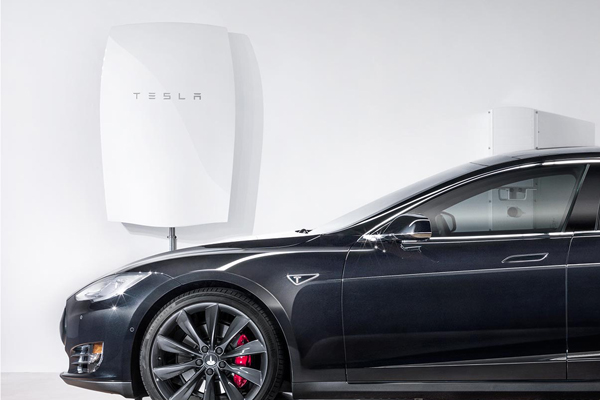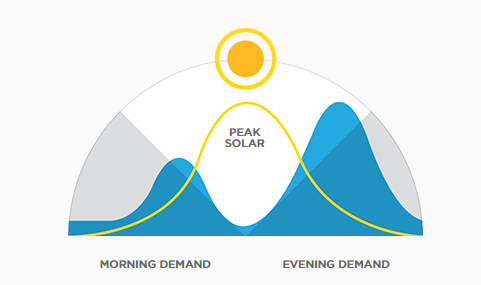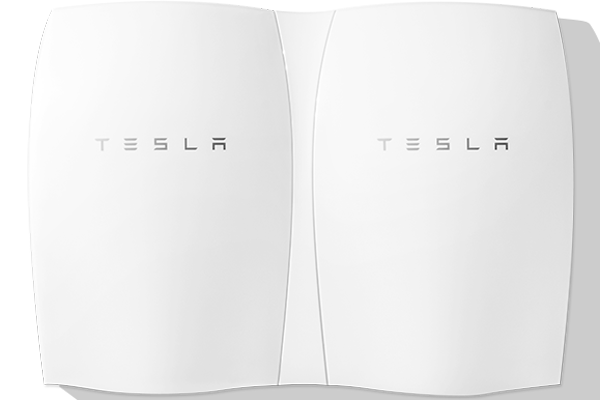Tesla Powerwall Battery Ready to Power Your Home
First Tesla revolutionized batteries for electric vehicles, now it's looking to do the same for homes with its Powerwall home battery.

Tesla’s batteries changed the way we think about electric vehicles. Now, it’s tech is coming to your home.
Tesla Energy, a new division of the company most well-known for its sporty and luxurious battery-powered cars, announced its first product: the Tesla Powerwall Home Battery. It’s goal is to provide an easy-to-install and easy-to-use lithium-ion battery system that provides efficient energy to a sustainable home.
The Powerwall will come in two versions: a $3,000 7kWh model and a larger $3,500 10 kWh unit that buyers can mount to a wall on their house. This lets home owners with solar panels store electricity during the day and save it for use in the morning or at night when demand is highest.

For those without solar panels, the benefit of Powerwall comes from collecting energy from the grid during the day when electricity rates are cheaper, and storing it for use later. In the event of a power outage, Powerwall automatically switches on, providing juice to your home while you wait.

The Powerwall is looks sleek but it's 7 inches thick and weighs a hefty 220 pounds. It can be daisy chained to additional units if you’re looking for more capacity. Tesla cites 92 percent round-trip DC efficiency with voltage between 350 and 450 volts and a 5 amp nominal output that peaks at 8.5 amps.
There’s also a larger commercial model called the Powerpack, which connects multiple 100 kWh units together for energy hungry companies such as Amazon, Wal-Mart and Target, which have begun integrating the battery unit from Tesla.
Tesla says Powerwall units will arrive this summer. You can reserve one now, but you’ll need a licensed technician to install it.
Sign up to get the BEST of Tom's Guide direct to your inbox.
Get instant access to breaking news, the hottest reviews, great deals and helpful tips.
More Smart Home Coverage from Tom's Guide
Sam Rutherford is a Staff Writer at Tom’s Guide. Follow him @SamRutherford on Twitter, and Tom’s Guide on Twitter, Facebook and Google+.
Sam is a Senior Writer at Engadget and previously worked at Gizmodo as a Senior Reporter. Before that, he worked at Tom's Guide and Laptop Mag as a Staff Writer and Senior Product Review Analyst, overseeing benchmarks and testing for countless product reviews. He was also an archery instructor and a penguin trainer too (really).
-
Onus If that is a total equipment price (i.e. it includes the inverter(s), grid-tie components, charger, and necessary wiring, it's not a bad price, not a bad size, and not a bad weight. Getting 10kWH from lead-acid batteries is a LOT more involved.Reply
Edit: It appears to omit the "AC-DC inverter," which would be the charger. Since this is apparently a high-voltage DC system, that could turn out to be a very expensive and/or proprietary component. More information is needed.
-
Vlad Rose I do agree that it is not a bad price, size or weight.Reply
As an emergency backup or a charger for your hybrid, it's not a bad option as gas generators at 7kWh start at a minimum of over $1000, closer to $2000.
However, I would not recommend someone getting something like this to save money by trying to use stored 'low demand' power during 'high demand' time periods. Average prices of electricity by the grid is around 10-20 cents per kWh per state, so the variation between low usage and peak usage isn't much. -
StarBound This news came as South Africa entered its power crisis. No idea what shipping would cost but the demand would inflate the price to triple if not quadruple. It is an irrecoverable cost due to poor planning. There also isn't mention of how long it lasts.Reply
Even with electricity prices as high as they are at $1000 it will take 10 years to make investing in one worth it. -
wiyosaya ReplyIf that is a total equipment price (i.e. it includes the inverter(s), grid-tie components, charger, and necessary wiring, it's not a bad price, not a bad size, and not a bad weight. Getting 10kWH from lead-acid batteries is a LOT more involved.
It almost certainly has a charge controller and charger, AC-DC inverter as you term it, included. If it did not, there would be no means of charging it.
Edit: It appears to omit the "AC-DC inverter," which would be the charger. Since this is apparently a high-voltage DC system, that could turn out to be a very expensive and/or proprietary component. More information is needed.
And, at least as I see it, other than size, getting 10kWh from lead-acid batteries is no more involved than getting the right charge controller, or getting a programmable charge controller, and getting the right batteries, i.e., deep-cycle batteries that are not the same as those designed for automotive use.
This news came as South Africa entered its power crisis. No idea what shipping would cost but the demand would inflate the price to triple if not quadruple. It is an irrecoverable cost due to poor planning. There also isn't mention of how long it lasts.
How long it lasts depends on how much power is drawn from it - if that is what you mean. Otherwise, the lifetime of the pack is probably the same as most current li batteries.
Even with electricity prices as high as they are at $1000 it will take 10 years to make investing in one worth it. -
razor512 Battery power for solar has been tried before, and it has failed. The limitation is one of technology, the batteries have limited charge cycles, and lose capacity with each charge cycle. The issue with this is that, people who have installed a battery system instead of a reverse meter to put power back into the grid and receive a credit for them, have not saved money.Reply
They will see lower bills for the first few years, but then the battery begins to fail the self tests, and then they need to replace it for a cost higher than all of the money that they had saved.
This is why the market has moved to people pumping the money back into the grid, and thus offsetting their electricity usage during the day (a decent system will essentially generate enough power to cover your electrical use, with some extra to put back into the grid. The credit then works to help offset the electrical energy that you use at night. This offers a consistent ROI, that will essentially last the life of the panels (upwards of 25 years depending on the quality).
-
nitrium How long do these batteries last - i.e. how often will they need replacing? If you have to replace these very five years or something, they are obviously not going to be REMOTELY cost effective.Reply -
JonTuxIvy 10 year warranty. Its the equivalent of an iphone for batteries. Lump together a bunch of existing technologies, make it pretty, and market market market.Reply
This is an attempt to establish a market for the gigafactory surplus since they cant sell enough cars to meet its production capacity.
The stock always tells the story...Tesla is down 9.5 today. If it was a uniquely new product, they would be up. -
Vlad Rose Reply15784932 said:10 year warranty. Its the equivalent of an iphone for batteries. Lump together a bunch of existing technologies, make it pretty, and market market market.
This is an attempt to establish a market for the gigafactory surplus since they cant sell enough cars to meet its production capacity.
The stock always tells the story...Tesla is down 9.5 today. If it was a uniquely new product, they would be up.
Actually, It's their supply that's that problem, not their sales. If you want to buy one of their cars, you're looking at an upward of 3 months unless you want their highest end model, which is still around a 20 day wait. It's not uncommon for the workers there to be doing 6 day/12 hour shifts right now.
Their stocks are down because the company is losing money currently with all their projects going on and not enough revenue to support it.
http://www.wsj.com/articles/tesla-posts-short-waiting-time-for-upscale-p85d-model-s-1426013218
http://www.glassdoor.com/Reviews/Tesla-Motors-Reviews-E43129.htm -
none12345 Lot of questions about this and few answers it seems. Does it have a built in ac->dc charger for the battery, does it have a built in dc->dc converter to output something lower then 350-400 volts, ie 48vReply
If it only is a 350-400v battery, with no dc-dc output management. Then this is not friendly to most existing inverters. The most common voltage by far is 48v.
There are advantages for using higher voltages, but if you cant find equipment...
I guess well have to wait for more details. -
jhpoland If it were a Battery of 48 volts or even 96 votls or 110VDC it would lend to solar and wind power storage . So at least a special charger and inverter are needed.Reply
Making Edison Iron Batteries that are in these voltages a Better deal Over All when compared to Litium in life and discharge rate in a voltage you can get an excellent over the counter inverter /Charger for in stores Now !
